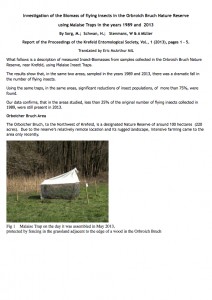This paper, an Investigation of the Biomass of flying insects in the Orbroich Bruch Nature Reserve near Krefeld, Germany, and the italicized notes below, came yesterday from Graham White in Scotland. Worldwide the environmental destruction is enormous. This recent exploratory study by the USGS, Native Bees Foraging in Fields Are Exposed to Neonicotinoid Insecticides, found neonics in native bees right here in the grasslands of northeastern Colorado far removed from agriculture. Even were we to wave a magic wand and stop the use of neonics today, it will likely take years for the environment to purge itself of these poisons.
Please see attached a science study published by the Krefeld Entomological Society in the Orbroich Bruch Nature Reserve – a wetland and water meadow area near Krefeld in Germany. The reserve has been managed for conservation objectives for many decades.
In 1989 – when flying insects were trapped, identified and the total weight of insects was recorded in grat detail.
Twenty five years later, in 2013, the same experiment was duplicated: using the same insect traps, on the same sites, in the same Nature Reserve and over the same sampling periods.
The entomologists describe their results as “frightening”.
The biomass of insects trapped in 2013 had fallen to less than 20% of the biomass collected in 1989 – and during some collecting periods, the biomass had fallen to less than 10% of 1989 levels.
The decline was not merely the physical biomass of insects, but was also reflected in a decline in the variety of species and taxa.
This ecological collapse took place within a designated Nature Reserve which has been specifically managed to maximise “conservation benefits” for over 25 years.
Pesticides and herbicides had been used on grassland areas nearby and neonicotinoid coated seeds are used on farmers fields, which surround the reserve, but the massive decline in flying insects within the reserve itself came as a great shock.
The accelerating decline of insect life parallels the decline of other wildlife species in the reserve, notably the Shrike – which bred widely in the reserve up to the 1960s but has now entirely vanished – largely because of the disappearance of the beetles and grasshoppers which the Shrike depended on to feed its chicks.
The study could not determine the ‘cause’ of this ecological collapse but concludes that if the decline of insects continues at the current tate, the reserve could be facing ecological collapse as soon as 2025.
Given the extensive use of herbicides, fungicides and pesticides in adjacent fields, the obvious hypothesis is that these biocides are spreading into the Nature Reserve via air and water, and decimating insect populations.
The implications of all this, for wildlife of all kinds in Europe – but especially for insectivorous birds – are extremely alarming.
One wonders if any similar time-comparison studies of insect life being carried out by wildlife organisations in the UK and USA?
– Graham White

